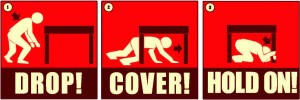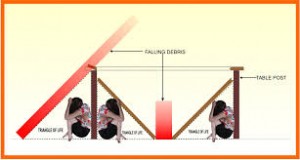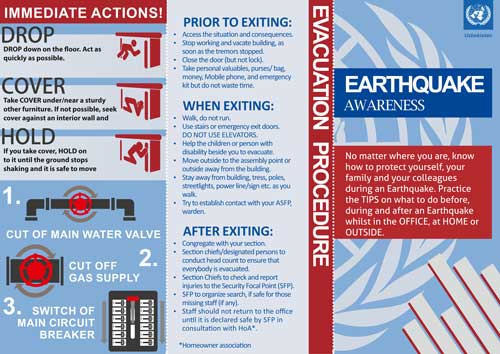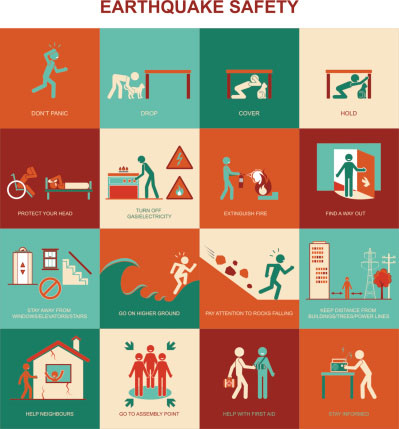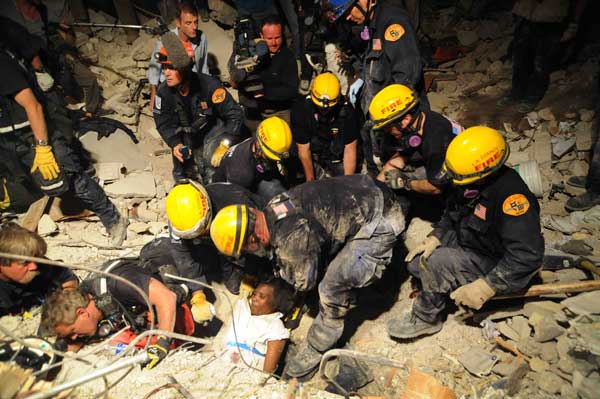- sirhow
- title case
- check huroob status
- check computer information
- delete snapchat messages
- profile picture microsoft teams
- redglitch filter instagram
- protect sheets amp ranges
- check passport status
- check cibil score online
- check android specs
- check computer age
- write article on sirhow
- celebrate eid
- career in writing
- help poor people
- help poor peoples
- use pocket wifi
- safe during earthquake
- watch live cricket
How to stay safe during an earthquake
Earthquakes are a common occurrence, rumbling below Earth's surface thousands of times every day. But major earthquakes are less common. Here are some things to do to prepare for an earthquake and what to do once the ground starts shaking. 
10 Ways to Survive an Earthquake, According to Experts
Safe during an earthquake - Tips
- Have an earthquake readiness plan.
- Consult a professional to learn how to make your home sturdier, such as bolting bookcases to wall studs, installing strong latches on cupboards, and strapping the water heater to wall studs.
- Locate a place in each room of the house that you can go to in case of an earthquake. It should be a spot where nothing is likely to fall on you.
- Keep a supply of canned food, an up-to-date first aid kit, 3 gallons (11.4 liters) of water per person, dust masks and goggles, and a working battery-operated radio and flashlights.
- Know how to turn off your gas and water mains.
If Shaking Begins
- Drop down; take cover under a desk or table and hold on.
- Stay indoors until the shaking stops and you're sure it's safe to exit.
- Stay away from bookcases or furniture that can fall on you.
- Stay away from windows. In a high-rise building, expect the fire alarms and sprinklers to go off during a quake.
- If you are in bed, hold on and stay there, protecting your head with a pillow.
- If you are outdoors, find a clear spot away from buildings, trees, and power lines. Drop to the ground.
- If you are in a car, slow down and drive to a clear place. Stay in the car until the shaking stops.
Your past experience in earthquakes may give you a false sense of safety; you didn't do anything, or you ran outside, yet you survived with no injuries. Or perhaps you got under your desk and others thought you overreacted.
However, you likely have never experienced the kind of strong earthquake shaking that is possible in much large earthquakes: sudden and intense back and forth motions of several feet per second will cause the floor or the ground to jerk sideways out from under you, and every unsecured object around you could topple, fall, or become airborne, potentially causing serious injury.
This is why you must learn to immediately protect yourself after the first jolt... don't wait to see if the earthquake shaking will be strong!
In MOST situations, you will reduce your chance of injury if you:
- DROP down onto your hands and knees (before the earthquakes knocks you down). This position protects you from falling but allows you to still move if necessary.
- COVER your head and neck (and your entire body if possible) under a sturdy table or desk. If there is no shelter nearby, only then should you get down near an interior wall (or next to low-lying furniture that won't fall on you), and cover your head and neck with your arms and hands.
- HOLD ON to your shelter (or to your head and neck) until the shaking stops. Be prepared to move with your shelter if the shaking shifts it around.
Wherever you are, protect yourself! You may be in situation where you cannot find shelter beneath furniture (or low against a wall, with your arms covering your head and neck).
It is important to think about what you will do to protect yourself wherever you are. What if you are driving, in a theater, in bed, at the beach, etc.?
Step 5 of the Seven Steps to Earthquake Safety describes what to do in various situations, no matter where you are when you feel earthquake shaking.
HOW PEOPLE WITH DISABILITIES CAN PROTECT THEMSELVES
Updated! Earthquake Preparedness Guide for People with Disabilities and Other Access or Functional Needs (8 pages) (PDF | RTF) Updated! Key Earthquake Safety Tips for People with Disabilities and Other Access or Functional Needs (2 pages) (PDF | RTF)
WHY RESCUERS AND EXPERTS RECOMMEND DROP, COVER, AND HOLD ON
Trying to moving during shaking puts you at risk: Earthquakes occur without any warning and may be so violent that you cannot run or crawl; you therefore will most likely be knocked to the ground where you happen to be.
So it is best to drop before the earthquake drops you, and find nearby shelter or use your arms and hands to protect your head and neck.
"Drop, Cover, and Hold On" gives you the best overall chance of quickly protecting yourself during an earthquake... even during quakes that cause furniture to move about rooms, and even in buildings that might ultimately collapse.
The greatest danger is from falling and flying objects: Studies of injuries and deaths caused by earthquakes over the last several decades show that you are much more likely to be injured by falling or flying objects (TVs, lamps, glass, bookcases, etc.) than to die in a collapsed building.
"Drop, Cover, and Hold On" (as described above) will protect you from most of these injuries. If there is no furniture nearby, you can still reduce the chance of injury from falling objects by getting down next to an interior wall and covering your head and neck with your arms (exterior walls are more likely to collapse and have windows that may break).
If you are in bed, the best thing to do is to stay there and cover your head with a pillow. Studies of injuries in earthquakes show that people who moved from their beds would not have been injured if they had remained in bed. You can also reduce your change of injury or damage to your belongings by securing them in the first place.
Secure top heavy furniture to walls with flexible straps. Use earthquake putty or velcro fasteners for objects on tables, shelves, or other furniture. Install safety latches on cabinets to keep them closed. Instructions for how to "secure your space" are at www.daretoprepare.org.
Building collapse is less of a danger: While images of collapsed structures in earthquakes around the world are frightening and get the most attention from the media, most buildings do not collapse at all, and few completely collapse.
In earthquake prone areas of the U.S. and in many other countries, strict building codes have worked to greatly reduce the potential of structure collapse. However, there is the possibility of structural failure in certain building types, especially unreinforced masonry (brick buildings), and in certain structures constructed before the latest building codes.
Rescue professionals are trained to understand how these structures collapse in order to identify potential locations of survivors within "survivable void spaces.
" The main goal of "Drop, Cover, and Hold On" is to protect you from falling and flying debris and other nonstructural hazards, and to increase the chance of your ending up in a Survivable Void Space if the building actually collapses.
The space under a sturdy table or desk is likely to remain even if the building collapses- pictures from around the world show tables and desks standing with rubble all around them, and even holding up floors that have collapsed.
Experienced rescuers agree that successfully predicting other safe locations in advance is nearly impossible, as where these voids will be depends on the direction of the shaking and many other factors. (See "triangle of life" below.)
The ONLY exception to the "Drop, Cover and Hold On" rule is if you are in a country with unengineered construction, and if you are on the ground floor of an unreinforced mud-brick (adobe) building, with a heavy ceiling.
In that case, you should try to move quickly outside to an open space. This cannot be recommended as a substitute for building earthquake-resistant structures in the first place!
WHAT RESCUERS AND EXPERTS *DO NOT* RECOMMEND YOU DO DURING AN EARTHQUAKE
- Based on years of research about how people are injured or killed during earthquakes, and the experiences of U.S. and international search and rescue teams, these three actions are not recommended to protect yourself during earthquakes:
- DO NOT run outside or to other rooms during shaking: The area near the exterior walls of a building is the most dangerous place to be.
Windows, facades and architectural details are often the first parts of the building to collapse. To stay away from this danger zone, stay inside if you are inside and outside if you are outside. Also, shaking can be so strong that you will not be able to move far without falling down, and objects may fall or be thrown at you that you do not expect.
Injuries can be avoided if you drop to the ground before the earthquake drops you. - DO NOT stand in a doorway: An enduring earthquake image of California is a collapsed adobe home with the door frame as the only standing part. From this came our belief that a doorway is the safest place to be during an earthquake.
True- if you live in an old, unreinforced adobe house or some older woodframe houses. In modern houses, doorways are no stronger than any other part of the house, and the doorway does not protect you from the most likely source of injury- falling or flying objects. You also may not be able to brace yourself in the door during strong shaking. You are safer under a table.
- Ask them to send this link to everyone they sent the "triangle" email, and to the person who sent it to them. Thank you! DO NOT get in the "triangle of life": In recent years, an e-mail has been circulating which describes an alternative to the long-established "Drop, Cover, and Hold On" advice.
The so-called "triangle of life" and some of the other actions recommended in the e-mail are potentially life threatening, and the credibility of the source of these recommendations has been broadly questioned (see links at left). - The "triangle of life" advice (always get next to a table rather than underneath it) is based on several wrong assumptions:
- buildings always collapse in earthquakes (wrong- especially in developed nations, and flat "pancake" collapse is rare anywhere);
- when buildings collapse they always crush all furniture inside (wrong- people DO survive under furniture or other shelters);
- people can always anticipate how their building might collapse and anticipate the location of survivable void spaces (wrong- the direction of shaking and unique structural aspects of the building make this nearly impossible) ; and
- during strong shaking people can move to a desired location (wrong- strong shaking can make moving very difficult and dangerous).
Some other recommendations in the "triangle of life" e-mail are also based on wrong assumptions and very hazardous. For example, the recommendation to get out of your car during an earthquake and lie down next to it assumes that there is always an elevated freeway above you that will fall and crush your car.
Of course there are very few elevated freeways, and lying next to your car is very dangerous because the car can move and crush you, and other drivers may not see you on the ground! A compilation of rebuttals from many organizations to these alternative recommendations, as well as news articles about the controversy, is listed at left.
PRACTICE THE RIGHT THING TO DO… IT COULD SAVE YOUR LIFE
You will be more likely to react quickly when shaking begins if you have actually practiced how to protect yourself on a regular basis. A great time to practice Drop, Cover, and Hold On is by participating in a Great ShakeOut Earthquake Drill (each October in most areas). Source : http://environment.nationalgeographic.com/

